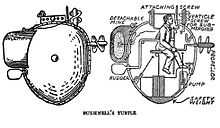HMS Eagle (1774)
For other ships of the same name, see HMS Eagle.
| Career (UK) | |
|---|---|
| Name: | HMS Eagle |
| Ordered: | 14 January 1771 |
| Builder: | Wells, Rotherhithe |
| Laid down: | April 1771 |
| Launched: | 2 May 1774 |
| Honours and awards: |
Participated in: Battle of Sadras (1782)Battle of Providien (1782) Battle of Negapatam (1782) Battle of Trincomalee (1782) Battle of Cuddalore (1783) |
| Fate: | Broken up, Chatham UK, October 1812 |
| General characteristics [1] | |
| Class and type: | Intrepid-class ship of the line |
| Tons burthen: | 1372 bm |
| Length: | 159 ft 6 in (48.62 m) (gun deck) |
| Beam: | 44 ft 4 in (13.51 m) |
| Draught: | 10 ft 8 in (3.25 m) |
| Depth of hold: | 19 ft (5.8 m) |
| Propulsion: | Sails |
| Sail plan: | Full rigged ship |
| Armament: | 64 guns:
|
HMS Eagle was a 64-gun third rate ship of the line of the Royal Navy, launched on 2 May 1774 at Rotherhithe.[1]

A diagram of the American Turtle
On 7 September 1776, the experimental American submarine Turtle, under the guidance of army volunteer Sergeant Ezra Lee, attacked HMS Eagle, which was moored off what is today called Liberty Island, but was unable to bore through the hull. When Lee attempted another spot in the hull, he lost the ship, and eventually abandoned the attempt. Eagle went on to take part in the Battle of Cuddalore in 1783.[2]
Eagle was on harbour service from 1790, and was broken up in 1812.[1]
Notes
References
- Lavery, Brian (2003) The Ship of the Line - Volume 1: The development of the battlefleet 1650-1850. Conway Maritime Press. ISBN 0-85177-252-8.
- Winfield, Rif (2007). British Warships in the Age of Sail: 1714-1792. Seaforth Publishing. ISBN 9781844157006.